EN MACHIN
Page 36
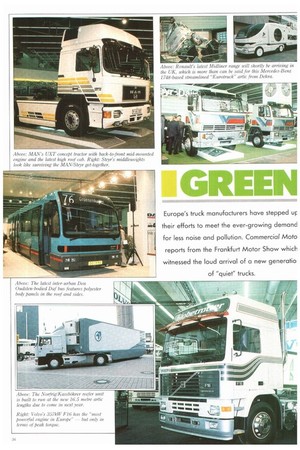
Page 37
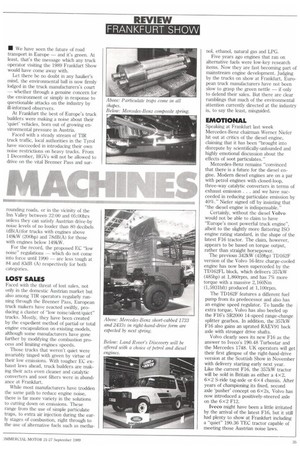
Page 38
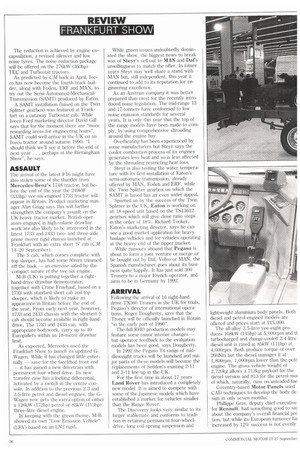
Page 39
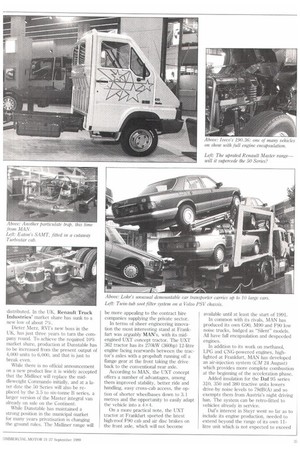
Page 40
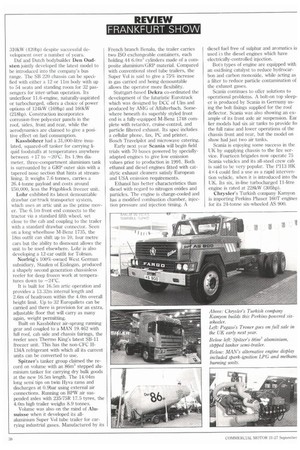
If you've noticed an error in this article please click here to report it so we can fix it.
• We have seen the future of road transport in Europe — and it's green. At least, that's the message which any truck operator visiting the 1989 Frankfurt Show would have come away with.
Let there be no doubt in any haulier's mind, the environmental ball is now firmly lodged in the truck manufacturers's court — whether through a genuine concern for the environment or simply in response to questionable attacks on the industry by ill-informed observers.
At Frankfurt the best of Europe's truck builders were making a noise about their 'quiet' vehicles, born out of growing environmental pressure in Austria.
Faced with a steady stream of TIR truck traffic, local authorities in the Tyrol have succeeded in introducing their own noise restrictions on heavy trucks. From 1 December, HGVs will not be allowed to drive on the vital Brenner Pass and sur rounding roads, or in the vicinity of the Inn Valley between 22:00 and 05:00hrs unless they can satisfy Austrian drive-by noise levels of no louder than 80 decibels (dB(A))for trucks with engines above 149kW (200hp) and 78dB(A) for those with engines below 149kW.
For the record, the proposed EC "low noise" regulations — which do not come into force until 1990 — are less tough at 84 and 83dB (A) respectively for both categories.
LOST SALES
Faced with the threat of lost sales, not only in the domestic Austrian market but also among -FIR operators regularly running through the Brenner Pass, European truck makers have reacted swiftly, producing a cluster of "low noise/silent/quiet" trucks. Mostly, they have been created by the expedient method of partial or total engine encapsulation on existing models, although some manufacturers have gone further by modifying the combustion process and limiting engines speeds.
Those trucks that weren't quiet were invariably tinged with green by virtue of their low emissions. With tougher EC exhaust laws ahead, truck builders are making their acts even cleaner and catalytic converters and soot filters were in abundance at Frankfurt.
While most manufacturers have trodden the same path to reduce engine noise, there is far more variety in the solutions to cutting down on emissions. These range from the use of simple particulate traps, to extra air injection during the early stages of combustion, right through to the use of alternative fuels such as metha nol, ethanol, natural gas and LPG.
Five years ago engines that ran on alternative fuels were low-key research items. Now they are fast becoming part of mainstream engine development. Judging by the trucks on show at Frankfurt, European truck manufacturers have not been slow to grasp the green nettle — if only to defend their sales. But there are clear rumblings that much of the environmental attention currently directed at the industry Is, to say the least, misguided.
EMOTIONAL
Speaking at Frankfurt last week Mercedes-Benz chairman Werner Niefer hit out at critics of the diesel engine, claiming that it has been "brought into disrepute by scientifically-unfounded and highly emotional discussion about the effects of soot particulates."
Mercedes-Benz remains "convinced that there is a future for the diesel engine. Modern diesel engines are on a par with petrol engines with closed-loop, three-way catalytic converters in terms of exhaust emission. . . and we have succeeded in reducing particulate emission by 40%." Niefer signed off by insisting that "the diesel engine is indispensable."
Certainly, without the diesel Volvo would not be able to claim to have "Europe's most powerful truck engine", albeit to the slightly more flattering ISO engine rating standard, in the shape of the latest F16 tractor. The claim, however, appears to be based on torque output, rather than straight horsepower.
The previous 342kW (459hp) TD162F version of the Volvo 16-litre charge-cooled engine has now been superceded by the TD162FL block, which delivers 357kW (485hp) at 1,860rprn, and has 7% more torque with a massive 2,160Nm (1,5931bft) produced at 1,100rpm.
The TD162F features a different fuel pump from its predecessor and also has an engine speed regulator. To handle the extra torque, Volvo has also beefed up the F16's SR2000 14-speed range-change splitter gearbox. In addition, the 357kW F16 also gains an uprated RAEV91 back axle with stronger drive shafts.
Volvo clearly sees its new F16 as the answer to Iveco's 190.48 Turbostar and the Mercedes 1748. UK operators will get their first glimpse of the right-hand-drive version at the Scottish Show in November with delivery starting early next year. Like the current F16, the 357kW tractor will be sold in Britain as either a 4x 2, 6x2 S-ride tag-axle or 6x4 chassis. After years of championing its fixed, second axle 'pusher' concept on 6x 2s, Volvo has now introduced a positively-steered axle on the 6x2 F12.
lveco might have been a little irritated by the arrival of the latest F16, but it still had plenty to show at Frankfurt including a "quiet" 190.36 TEC tractor capable of meeting those Austrian noise laws. The reduction is achieved by engine encapsulation, a revised silencer and low noise tyres. The noise reduction package will be offered on the 276kW (360hp) TEC and Turbostar tractors.
As predicted by CM back in April, lyeco has now become the fourth truck builder, along with Foden, ERF and MAN, to try out the Semi-Automated-MechanicalTransmission (SAMT) produced by Eaton.
A SAMT installation (based on the Twin Splitter gearbox) was featured at Frankfurt on a cutaway Turbostar cab. While Iveco Ford marketing director David Gill says that for the moment there are "more rewarding areas for engineering hours", SAMT could well arrive in the UK on an lveco tractor around autumn 1990. "I should think we'll see it before the end of next year . . . perhaps at the Birmingham Show", he says.
ASSAULT
The arrival of the latest F16 might have also stolen some of the thunder from Mercedes-Benz's 1748 tractor, but before the end of the year the 299kAT (333hp) vee-six-engined 1733 tractor will appear in Britain. Product marketing manager Alan Grigg says this will further strengthen the company's assault on the UK heavy tractor market. British operators engaged in high-volume drawbar work are also likely to be interested in the latest 1733 and 2933 twoand three-axle prime mover rigid chassis launched at Frankfurt with an extra short 'S' cab (CM 14-20 September).
The S cab, which comes complete with top sleeper, has had son-le ROmm trimmed off the back — an exercise aided by the compact nature of the vee-six engine.
M-B (UK) is putting together a righthand-drive drawbar demonstrator, together with Crane Fruehauf, based on a 1733 with standard short cab and top sleeper, which is likely to make an appearance in Britain before the end of the year. From early next year, however, 1733 and 2433 chassis with the shortest S cab should become available in right-handdrive. The 1733 and 2433 can, with appropriate bodywork, carry up to .10 EuropaIlets within an 18-metre drawbar limit.
As expected, Mercedes used the Frankfurt Show to launch its updated GAragen. While it has changed little externally — save for the facelifted front end it has gained a new drivetrain with permanent four-wheel-drive. Its new transfer case has a locking differential, activated by a switch in the centre console. In addition to the previous 2.3 and 2.5-litre petrol and diesel engines, the GWagen now gets the extra option of either a 126kW (172hp) petrol or 83kW (113hp) three-litre diesel engine.
In keeping with the green theme, M-B showed its own "Low Emission Vehicle" (LEV) based on an LN2 rigid. While green issues undoubtedly dominated the show, the biggest news to break was of Steyr's sell-out to MAN and Das unwillingness to match the offer. In future years Steyr may well share a stand with MAN but, still independent, this year it continued to add to its reputation for engineering excellence.
As an Austrian company it was better prepared than most for the recently introduced noise legislation. The mid-range 13 and 17-tonners have conformed to low noise emission standards for several years. It is only this year that the top of the range models have been made to comply, by using comprehensive shrouding around the engine bay.
Overheating has been experienced by some manufacturers but Steyr says the cooler combustion process of its engines generates less heat and so is less affected by the shrouding restricting heat loss.
Steyr is also testing the water temperature with its first installation of Eaton's semi-automatic transmission, already offered by MAN, Foden and ERF, while the Twin Splitter gearbox on which the SAMT is based has an even wider appeal.
Spurred on by the success of the Twin Splitter in the UK, Eaton is working on an 18-speed unit based on the TS13612 gearbox which will give close ratio steps in the order of 18%. Richard Tooker. Eaton's marketing director, says he can see a' good market application for heavy haulage vehicles and for vehicles operating at the heavy end of the tipper market.
While rumours abound that Pegaso is about to form a joint venture or merge or be bought out by Daf, Volvo or MAN, the Spanish manufacturer goes about its business quite happily. It has just sold 300 Troners to a major French operator, and aims to be in Germany by 1992.
ARRIVAL
Following the arrival of 10 right-handdrive TX360 Troners in the UK for trials, Pegaso's director of international operations, Roger Dougherty, says that the Troner will be officially launched in Britain "in the early part of 1990".
The full RHD production models may feature some minor interior changes — but operator feedback to the evaluation models has been good, says Dougherty.
In 1992 the Pegaso T4 range of middleweight trucks will be launched and major parts of these models will become the replacements of Seddon's existing 2-11 and 3-11 line-up in the UK.
For the first time in about 17 years Land Rover has introduced a completely new model. It is aimed to compete with some of the Japanese models which have established a market for vehicles smaller than the Range Rover.
The Discovery looks very similar to its larger stablemate and conforms to tradition in retaining permanent four-wheeldrive, long coil-sprung suspension and lightweight aluminium body panels. Both diesel and petrol-engined models are offered and prices start at .E15,000.
The all-alloy 3.5-litre we-eight produces 108kW (145hp) at 5,000rpm and ti turbocharged and charge-cooled 2.4-litre diesel unit is rated at 85kW (111hp) at 4,000rpm. Both produce torque of over 260Nm but the diesel manages it at 1,800rpm, 1,000rpm lower than the pctr engine. The gross vehicle weight of 2,720kg allows a 712kg payload for the diesel version and 813 for the petrol mol el which, naturally, runs on unleaded fue
Coventry-based Motor Panels used CAD techniques to develop the body design in only seven months.
PhiRippe Gras, deputy chief executive for Renault, had something good to sa), about the company's overall financial pos. tion, but while its European turnover ha increased by 12% success is not evenly distributed. In the UK, Renault Truck Industries' market share has sunk to a new low of about 7%.
Dieter Merz, RV1's new boss in the UK, has just three years to turn the company round. To achieve the required 10% market share, production at Dunstable has to be increased from the present output of 4,000 units to 6,000, and that is just to break even.
While there is no official announcement on a new product line it is widely accepted that the Midliner will replace the middleweight Commando initially, and at a later date the 50 Series will also be replaced by the 3.5 to six-tonne B series, a larger version of the Master integral van already on sale on the Continent.
While Dunstable has maintained a strong position in the municipal market for many years privatisation is changing the ground rules. The Midliner range will be more appealing to the contract hire companies supplying the private sector.
In terms of sheer engineering innovation the most interesting stand at Frankfurt was arguably MAN's, with its midengined UXT concept tractor. The UXT 362 tractor has its 270kW (360hp) 12-litre engine facing rearwards between the tractor's axles with a propshaft running off a flange gear at the front taking the drive back to the conventional rear axle.
According to MAN, the UXT concept offers a number of advantages, among them improved stability, better ride and handling, easy cross-cab access, the option of shorter wheelbases down to 3.1 metres and the opportunity to easily adapt the vehicle into a 4x4.
On a more practical note, the UXT tractor at Frankfurt sported the latest high-roof F90 cab and air disc brakes on the front axle, which will not become available until at least the start of 1991.
In common with its rivals, MAN has produced its own G90, M90 and F90 low noise trucks, badged as "Silent" models. All have full encapsulation and &speeded engines.
In addition to its work on methanol, LPG and CNG-powered engines, highlighted at Frankfurt, MAN has developed an air-injection system (CM 24 August) which provides more complete combustion at the beginning of the acceleration phase.
Added insulation for the Daf 95 series 310, 350 and 380 tractive units lowers drive-by noise levels to 79dB(A) and so exempts them from Austria's night driving ban. The system can be retro-fitted to vehicles already in service.
Dais interest in Steyr went so far as to include its engine production, needed to extend beyond the range of its own 11litre unit which is not expected to exceed 310kW (420hp) despite successful development over a number of years. Daf and Dutch bodybuilder Den Oudsten jointly developed the latest model to be introduced into the company's bus range. The SB 220 chassis can be specified with either a 12 or Ilm body with up to 54 seats and standing room for 32 passengers for inter-urban operation. Its underfloor 11.6-engine, naturally-aspirated or turbocharged, offers a choice of power Options of 124kW (169hp) and 160kW (218hp). Construction incorporates corrosion-free polyester panels in the roof, sides, front and rear, while the aerodynamics are claimed to give a positive effect on fuel consumption.
Kassbohrer had a 31,000-litre insulated, squared-off tanker for carrying liquid foodstuffs at temperatures anywhere between +17 to —20°C. Its 1.9m diameter, three-compartment aluminium tank is surrounded by a GRP outer skin with a tapered nose section that hints at streamlining. It weighs 7.6 tonnes, carries a 26.4-tonne payload and costs around £50,000, less the Frigoblock freezer unit.
Lohr exhibited its latest demountable drawbar car/truck transporter system, which uses an artic unit as the prime mover. The 6.1m front end connects to the tractor via a standard fifth wheel, set close to the cab and coupling to the trailer with a standard drawbar connector. Seen on a long wheelbase M-Benz 1735, the 18in outfit can shift up to 10, four metre cars but the ability to dismount allows the unit to be used elsewhere. Lohr is also developing a 12-car outfit for Tolman.
Norfrig's l00%-owned West German subsidiary, Staufen of Eislingan, produced a shapely second generation chassisless reefer for deep frozen work at temperatures down to —24°C.
It is built for 16.5in artic operation and provides a 13.32m internal length and 2.6m of headroom within the 4.0m overall height limit, Up to 32 Europallets can be can-led and there is provision for an extra, adjustable floor that will carry as many again, weight permitting.
Built on KassbOhrer air-sprung running gear and coupled to a MAN 19.462 with full roof, cab side and chassis fairings, the reefer uses Thermo King's latest SB-11 freezer unit. This has the non-CFC II134A refrigerant with which all its current units can be converted to use.
Spitzer's tanker group claimed the record on volume with an 86m3 stepped aluminium tanker for carrying dry bulk goods at the new 16.5m length. The 14.04m long semi tips on twin Hyva rams and discharges at 0.9bar using external air connections. Running on BPW air suspended axles with 235/75R 17.5 tyres, the 4.0m high trailer weighs 8.9 tonnes.
Volume was also on the mind of Alusuisse when it developed its allaluminium Super Vol tube trader for carrying industrial gases. Manufactured by its French branch Benalu, the trailer carries two ISO exchangeable containers, each holding 44 6.0m3 cylinders made of a composite aluminium/GRP material. Compared with conventional steel tube trailers, the Super Vol is said to give a 75% increase in gas carried and being demountable allows the operator more flexibility.
Stuttgart-based Dekra co-ordinated the development of the futuristic Eurotruck which was designed by DCC of Ulm and produced by AMG of Affalterbach. Somewhere beneath its superbly styled front end is a fully-equipped M-Benz 1748 complete with retarder, cruise-control, and particle filtered exhaust. Its spec includes a cellular phone. fax, PC and printer, Bosch Travelpilot and microwave catering.
Early next year Scania will begin field trials with 70 buses powered by speciallyadapted engines to give low emission values prior to production in 1991. Both ethanol and diesel engines fitted with catalytic exhaust cleaners satisfy European and USA emission requirements.
Ethanol has better characteristics than diesel with regard to nitrogen oxides and particles. The engine is charge-cooled and has a modified combustion chamber, injection pressure and injection timing. A diesel fuel free of sulphur and aromatics is used i the diesel engines which have electrically-controlled injection.
Both types of engine are equipped with an oxidising catalyst to reduce hydrocarbon and carbon monoxide, while acting as a filter to reduce particle contamination of the exhaust gases.
Scania continues to offer solutions to operational problems. A bolt-on top sleeper is produced by Scania in Germany using the bolt fixings supplied for the roof deflector. Scalia was also showing an example of its front axle air suspension. Ear lier models had six air tanks to provide fol the full raise and lower operations of the chassis front and rear, but the model on show had just two air tanks.
Scania is enjoying some success in the UK by supplying chassis to the fire service. Fourteen brigades now operate 75 Scania vehicles and its all-steel crew cab is said to be very popular. The P113 HK 4x4 could find a use as a rapid intervention vehicle, when it is introduced into th( UK. Its six, in-line turbocharged 11-litre engine is rated at 228kW (305hp).
Chrysler's Turkish company Kamyon is importing Perkins Phaser 1601 engines for its 24-tonne six-wheeled AS 900.




























































































































































